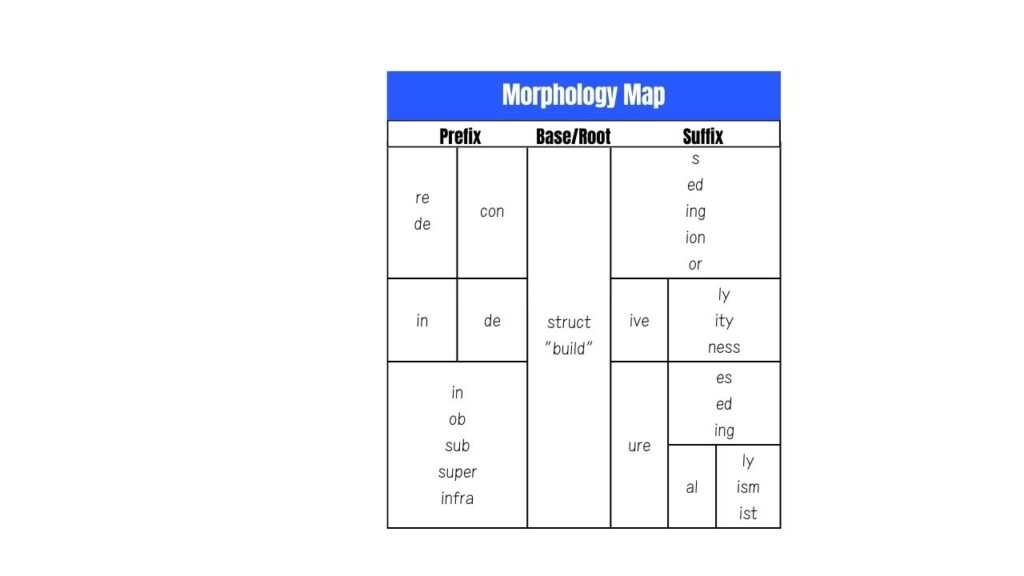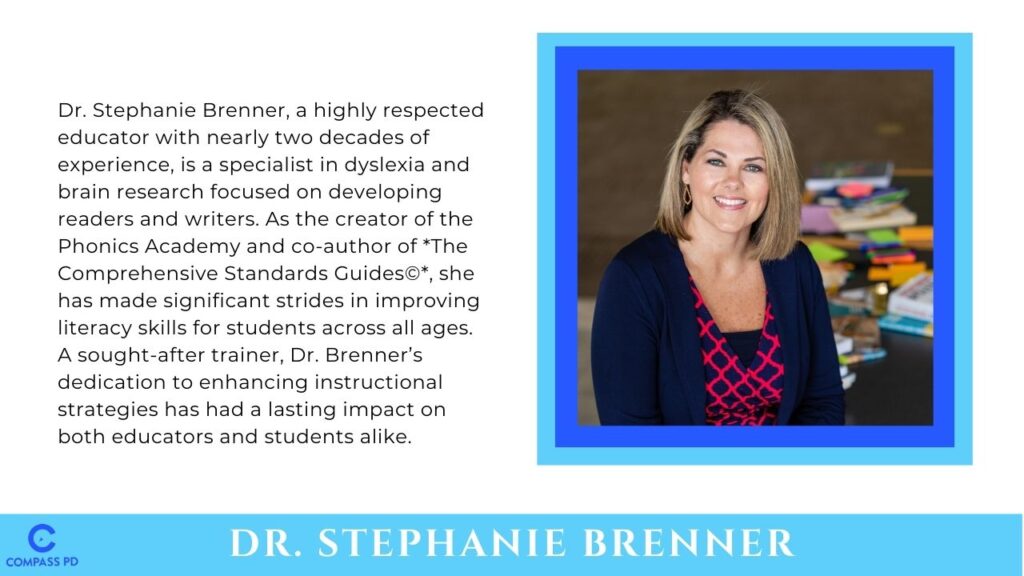Part 1 of: Teaching Students With Dyslexia 201: Diving Deeper into Practical Supports
By Dr. Stephanie Brenner
We are halfway through Dyslexia Awareness Month! Earlier, we explored what dyslexia is, the five key language systems essential for understanding dyslexia, common characteristics, and four ways to make a difference. With that foundation, it’s time to turn theory into action! Where should you start? Beginning with a focus on building knowledge of the key language systems is best because your knowledge base of language acquisition influences all instructional decisions. Supporting dyslexic students requires a solid understanding of these systems to tailor literacy instruction and intervention effectively. So, what does instruction in these systems look like, and how can you apply this knowledge to create inclusive classrooms where dyslexic students thrive? As educators, you already play a critical role in supporting all learners. These strategies enhance what you do best—tailoring instruction to meet each student’s unique needs.

Phonology: Building Strong Sound Awareness
Students with dyslexia often struggle to connect sounds to letters. Before associating print with sound, they must be able to isolate and manipulate individual sounds—the goal of phonological awareness activities. In your daily lessons, the key is incorporating phonological awareness activities that break down words into individual sounds. And YES—this applies to students beyond second grade! The core phonological deficit associated with dyslexia doesn’t disappear once students are in upper-grade levels.
What you can do:
- Rhyme Time: Incorporate rhyming games to strengthen sound recognition. Ask students to identify words that rhyme or create a rhyme chain.
Syllable Blending, Segmentation, and Manipulation: Practice breaking words into syllables, adding syllables, and deleting syllables.
| Compound Word | Multisyllabic Word | |
| Starting Word | backpack | elevate |
| Break Word Into Syllables | back, pack | el-e-vate |
| Delete Final Syllable* | back | el-e |
| Add A Final Syllable* | background | el-e-phant |
Sound Blending, Segmentation, and Manipulation: Practice breaking words into individual phonemes (sounds), adding phonemes, and deleting phonemes.
| Starting Word | hunter |
| Break Word Into Phonemes | /h/ /u/ /n/ /t/ /er/ |
| Delete Final Phoneme* | /h/ /u/ /n/ /t/ |
| Add A Final Phoneme* | /h/ /u/ /n/ /t/ /s/ |
- Elkonin Boxes (Sound Boxes): Use visual tools to help students map sounds to letters. Students can move counters into drawn boxes that represent each sound in a word, reinforcing the connection between phonemes and graphemes (printed letters representing a sound).
*The progression of phonological awareness skills begins with manipulation of the final word or sound segment, moves to the beginning word or sound segment, and then the medial segments or sounds.
Morphology: Breaking Down Word Structures
Students with dyslexia often struggle with decoding unfamiliar words. Morphology teaches students how to recognize and understand morphemes—base words, root words, prefixes, and suffixes—giving them tools to tackle new words confidently.
What you can do:Word Building: Teach students to break down complex words into morphological parts and the meaning of those parts.
| Starting Word: unhappiness | Meaning | |
| Prefix | un | not, opposite of |
| Base/Root Word | happy | feeling or showing contentment |
| Suffix | ness | state, condition, quality of being |
Morphological Mapping: Create visual charts that map out common prefixes and suffixes with their meanings. Reference these during lessons to reinforce word structures and word building.

Affix and Root Word Drills: Regularly practice decoding using root words and their extensions. If students know that struct means “to build,” it becomes easier to recognize words like construction or infrastructure.
Orthography: Strengthening Spelling and Word RecognitionOrthography focuses on the written system of language, matching the correct graphemes to the phonemes they represent. For example, the grapheme E represents /ě/ in the word bed, and the grapheme EIGH represents /ā/ in the word neigh. Dyslexic students often find spelling to be one of their biggest challenges and require explicit teaching of spelling patterns and rules in a systematic way rather than relying on rote memorization. Phonics is the instruction of correlating sounds with print for the purpose of reading and writing.
What you can do:
- Explicitly Teach Spelling Patterns and Rules: Teach common spelling patterns and rules using an explicit approach. For example, in first grade, instruction of the suffix -ed includes information regarding how it makes a word past tense and can represent the sounds /d/, /ěd/, or /t/ depending on the final sound of the base word. Additionally, in fourth grade, instruction of the suffix -tion will include how it can be represented with the graphemes -tion, -sion, or -ion depending on the final grapheme of the base or root word and that its meaning is act, state, or result of. The content of explicit instruction at each grade level is determined using a systematic approach.
Orthographic Mapping: The process used to make a connection between the phonemes in words and the correct spelling sequences, ultimately leading to fluent reading and writing.

Orthographic mapping incorporates multisensory techniques to help reinforce the connection between letters and their sounds. Additional techniques can be added as well (i.e., write the word in the air, trace letters on the table, use a silly voice when saying syllables or sounds aloud, etc.).
Repetitions In and Out of Context: For the dyslexic student, multiple repetitions are required before skills become accurate and fluent. Allowing for a variety of opportunities to interact with current and previous instruction provides those repetitions. During explicit teaching, Orthographic Mapping, reading, and writing words with target skills in isolation, phrases, sentences, and teacher-provided passages provide repetition. Additional repetition can occur during independent reading and writing, small group instruction, and conferences. Apps and websites that engage students in spelling, word recognition, and reading can be leveraged for additional repetition and immediate feedback. (Please note, providing repetition with activities like “rainbow writing” or copying words ten times are not research-based forms of instruction.)
I imagine your mind is already spinning and thinking of ways you can incorporate these strategies into your instruction. And there are still two components to discuss! Phonology, morphology, and orthography are the more commonly addressed systems of language when discussing instruction for students with dyslexia. In Part 2 of this blog series, we will go into detail on the remaining, less commonly taught, components- syntax and semantics. Be on the lookout soon!
References
Beck, I.L., McKeown, M.G. & Kucan, L. (2013). Bringing words to life: Robust vocabulary instruction (2nd ed.). The Guilford Press.
Ebbers, S.M. (2004). Vocabulary through morphemes: Suffixes, prefixes, and roots for intermediate grades. Sopris West Educational Services.
Hattie, J. (2023). Visible learning: The sequel: A synthesis of over 2,100 meta-analyses relating to achievement. Routledge.
Moats, L.C. (2020). Speech to print: Language Essentials for Teachers (3rd ed.). Paul H. Brookes Publishing Co. Shaywitz, S. & Shaywitz, J. (2020). Overcoming dyslexia (2nd ed.) Alfred A. Knopf, Inc.

